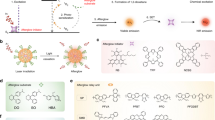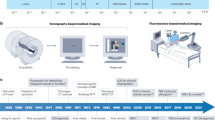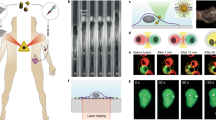Abstract
The characteristic blue glow of Cerenkov luminescence (CL) arises from the interaction between a charged particle travelling faster than the phase velocity of light and a dielectric medium, such as water or tissue. As CL emanates from a variety of sources, such as cosmic events, particle accelerators, nuclear reactors and clinical radionuclides, it has been used in applications such as particle detection, dosimetry, and medical imaging and therapy. The combination of CL and nanoparticles for biomedicine has improved diagnosis and therapy, especially in oncological research. Although radioactive decay itself cannot be easily modulated, the associated CL can be through the use of nanoparticles, thus offering new applications in biomedical research. Advances in nanoparticles, metamaterials and photonic crystals have also yielded new behaviours of CL. Here, we review the physics behind Cerenkov luminescence and associated applications in biomedicine. We also show that by combining advances in nanotechnology and materials science with CL, new avenues for basic and applied sciences have opened.
This is a preview of subscription content, access via your institution
Access options
Access Nature and 54 other Nature Portfolio journals
Get Nature+, our best-value online-access subscription
$29.99 / 30 days
cancel any time
Subscribe to this journal
Receive 12 print issues and online access
$259.00 per year
only $21.58 per issue
Buy this article
- Purchase on Springer Link
- Instant access to full article PDF
Prices may be subject to local taxes which are calculated during checkout







Similar content being viewed by others
References
Heaviside, O. The electromagnetic effect of a moving charge. The Electrician Vol. 2 83–84 (1888).
Cerenkov, P. Visible light from pure liquids under the impact of gamma-rays. C. R. Acad. Sci. Urss 3, 451–457 (1934).
Bolotovskii, B. M. Vavilov-Cherenkov radiation: its discovery and application. Phys-Usp. 52, 1099–1110 (2009).
Čerenkov, P. A. Visible radiation produced by electrons moving in a medium with velocities exceeding that of light. Phys. Rev. 52, 378–379 (1937).
Frank, I. & Tamm, I. Coherent visible radiation of fast electrons passing through matter. C. R. Acad. Sci. Urss 14, 109–114 (1937).
Ginzburg, V. L. The quantum theory of radiation of an electron uniformly moving in a medium. J. Phys. USSR 2, 441–452 (1940).
Choppin, G., Liljenzin, J.-O., Rydberg, J. & Ekberg, C. Radiochemistry and Nuclear Chemistry 4th edn (Academic Press, 2013).
Kaminer, I. et al. Quantum Cerenkov radiation: spectral cutoffs and the role of spin and orbital angular momentum. Phys. Rev. X 6, 011006 (2015).
Kobzev, A. P. The mechanism of Vavilov-Cherenkov radiation. Phys. Part. Nuclei 41, 452–470 (2010).
Kobzev, A. P. On the radiation mechanism of a uniformly moving charge. Phys. Part. Nuclei 45, 628–653 (2014).
Thorek, D. et al. Cerenkov imaging — a new modality for molecular imaging. Am. J. Nucl. Med. Mol. Imaging 2, 163–173 (2012).
Gill, R. K., Mitchell, G. S. & Cherry, S. R. Computed Cerenkov luminescence yields for radionuclides used in biology and medicine. Phys. Med. Biol. 60, 4263–4280 (2015).
Krizan, P. Recent progress in Cerenkov counters. IEEE Trans. Nucl. Sci. 48, 941–949 (2001).
Abeysekara, A. U. et al. Sensitivity of the high altitude water Cherenkov detector to sources of multi-TeV gamma rays. Astropart. Phys. 50–52, 26–32 (2013).
Chamberlain, O., Segre, E., Wiegand, C. & Ypsilantis, T. Observation of antiprotons. Phys. Rev. 100, 947–950 (1955).
Aubert, J. J. et al. Experimental observation of a heavy particle. J. Phys. Rev. Lett. 33, 1404–1406 (1974).
Augustin, J. E. et al. Discovery of a narrow resonance in e+e− annihilation. Phys. Rev. Lett. 33, 1406–1408 (1974).
Robertson, R. et al. Optical imaging of Cerenkov light generation from positron-emitting radiotracers. Phys. Med. Biol. 54, N355–N365 (2009). The first preclinical demonstration of in vivo CLI using injected radiotracers.
Beattie, B. J. et al. Quantitative modeling of Cerenkov light production efficiency from medical radionuclides. PloS ONE 7, e31402 (2012).
Boschi, F. et al. In vivo (18)F-FDG tumour uptake measurements in small animals using Cerenkov radiation. Eur. J. Nucl. Med. Mol. Imaging 38, 120–127 (2011).
Mitchell, G. S., Gill, R. K., Boucher, D. L., Li, C. & Cherry, S. R. In vivo Cerenkov luminescence imaging: a new tool for molecular imaging. Phil. Trans. R. Soc. A 369, 4605–4619 (2011).
Lohrmann, C. et al. Cerenkov luminescence imaging for radiation dose calculation of a 90Y-labeled gastrin-releasing peptide receptor antagonist. J. Nucl. Med. 56, 805–811 (2015).
Pandya, D. N. et al. Preliminary therapy evaluation of 225Ac-DOTA-c(RGDyK) demonstrates that Cerenkov radiation derived from 225Ac daughter decay can be detected by optical imaging for in vivo tumor visualization. Theranostics 6, 698–709 (2016).
Spinelli, A. E. et al. First human Cerenkography. J. Biomed. Opt. 18, 20502 (2013).
Thorek, D. L., Riedl, C. C. & Grimm, J. Clinical Cerenkov luminescence imaging of 18F-FDG. J. Nucl. Med. 55, 95–98 (2014).
Chin, P. T. et al. Optical imaging as an expansion of nuclear medicine: Cerenkov-based luminescence vs fluorescence-based luminescence. Eur. J. Nucl. Med. Mol. Imaging 40, 1283–1291 (2013).
Thorek, D. L., Ogirala, A., Beattie, B. J. & Grimm, J. Quantitative imaging of disease signatures through radioactive decay signal conversion. Nat. Med. 19, 1345–1350 (2013). A paper that shows how CL combinations with nanoparticle allows in vivo activatable molecular imaging.
Dothager, R. S., Goiffon, R. J., Jackson, E., Harpstrite, S. & Piwnica-Worms, D. Cerenkov radiation energy transfer (CRET) imaging: a novel method for optical imaging of PET isotopes in biological systems. PloS ONE 5, e13300 (2010). A paper showing how combining photoluminescent nanoparticles with CL allows deeper optical imaging depth.
Liu, H. et al. Radiation-luminescence-excited quantum dots for in vivo multiplexed optical imaging. Small 6, 1087–1091 (2010).
Hu, Z. et al. In vivo nanoparticle-mediated radiopharmaceutical-excited fluorescence molecular imaging. Nat. Commun. 6, 7560 (2015).
Ma, X. et al. Enhancement of Cerenkov luminescence imaging by dual excitation of Er3+, Yb3+-doped rare-earth microparticles. PloS ONE 8, e77926 (2013).
Kotagiri, N., Niedzwiedzki, D. M., Ohara, K. & Achilefu, S. Activatable probes based on distance-dependent luminescence associated with Cerenkov radiation. Angew. Chem. Int. Ed. 52, 7756–7760 (2013).
Kim, J. et al. Vivid tumor imaging utilizing liposome-carried bimodal radiotracer. ACS Med. Chem. Lett. 5, 390–394 (2014).
Perez-Medina, C. et al. A modular labeling strategy for in vivo PET and near-infrared fluorescence imaging of nanoparticle tumor targeting. J. Nucl. Med. 55, 1706–1711 (2014).
Rieffel, J. et al. Hexamodal imaging with porphyrin-phospholipid-coated upconversion nanoparticles. Adv. Mater. 27, 1785–1790 (2015).
Goel, S., Chen, F., Ehlerding, E. B. & Cai, W. Intrinsically radiolabeled nanoparticles: an emerging paradigm. Small 10, 3825–3830 (2014). A review on advances in radiolabeling nanoparticles for biomedical applications without using chelators or prosthetic groups.
Shaffer, T. M. et al. Silica nanoparticles as substrates for chelator-free labeling of oxophilic radioisotopes. Nano Lett. 15, 864–868 (2015).
Chen, F. et al. In vivo integrity and biological fate of chelator-free zirconium-89-labeled mesoporous silica nanoparticles. ACS Nano 9, 7950–7959 (2015).
Shaffer, T. M. Stable radiolabeling of sulfur-functionalized silica nanoparticles with copper-64. Nano Lett. 16, 5601–5604 (2016).
Boros, E., Bowen, A. M., Josephson, L., Vasdev, N. & Holland, J. P. Chelate-free metal ion binding and heat-induced radiolabeling of iron oxide nanoparticles. Chem. Sci. 6, 225–236 (2015).
Madru, R. et al. 68Ga-labeled superparamagnetic iron oxide nanoparticles (SPIONs) for multi-modality PET/MR/Cherenkov luminescence imaging of sentinel lymph nodes. Am. J. Nucl. Med. Mol. Imaging 4, 60–69 (2013).
Lee, S. B. et al. Radionuclide-embedded gold nanoparticles for enhanced dendritic cell-based cancer immunotherapy, sensitive and quantitative tracking of dendritic cells with PET and Cerenkov luminescence. NPG Asia Mater. 8, e281 (2016).
Lee, S. B. et al. Combined positron emission tomography and Cerenkov luminescence imaging of sentinel lymph nodes using PEGylated radionuclide-embedded gold nanoparticles. Small 12, 4894–4901 (2016).
Karn, P. R., Cho, W. & Hwang, S. J. Liposomal drug products and recent advances in the synthesis of supercritical fluid-mediated liposomes. Nanomedicine 8, 1529–1548 (2013).
Black, K. C. et al. In vivo fate tracking of degradable nanoparticles for lung gene transfer using PET and Cerenkov imaging. Biomaterials 98, 53–63 (2016).
Li, J. et al. Enhancement and wavelength-shifted emission of Cerenkov luminescence using multifunctional microspheres. Phys. Med. Biol. 60, 727–739 (2015).
Gibson, N. et al. Radiolabelling of engineered nanoparticles for in vitro and in vivo tracing applications using cyclotron accelerators. Arch. Toxicol. 85, 751–773 (2011).
Paik, T. et al. Shape-controlled synthesis of isotopic yttrium-90-labeled rare earth fluoride nanocrystals for multimodal imaging. ACS Nano 9, 8718–8728 (2015).
Black, K. C. et al. Radioactive 198Au-doped nanostructures with different shapes for in vivo analyses of their biodistribution, tumor uptake, and intratumoral distribution. ACS Nano 8, 4385–4394 (2014).
Zhao, Y. et al. Copper-64-alloyed gold nanoparticles for cancer imaging: improved radiolabel stability and diagnostic accuracy. Angew. Chem. Int. Ed. 53, 156–159 (2014).
Zhou, C. et al. Near-infrared emitting radioactive gold nanoparticles with molecular pharmacokinetics. Angew. Chem. Int. Ed. 51, 10118–10122 (2012).
Hu, H. et al. PET and NIR optical imaging using self-illuminating 64Cu-doped chelator-free gold nanoclusters. Biomaterials 35, 9868–9876 (2014).
Sun, X. et al. Self-illuminating 64Cu-doped CdSe/ZnS nanocrystals for in vivo tumor imaging. J. Am. Chem. Soc. 136, 1706–1709 (2014).
Guo, W. et al. Intrinsically radioactive [64Cu]CuInS/ZnS quantum dots for PET and optical imaging: improved radiochemical stability and controllable Cerenkov luminescence. ACS Nano 9, 488–495 (2015).
Ran, C., Zhang, Z., Hooker, J. & Moore, A. In vivo photoactivation without “light”: use of Cherenkov radiation to overcome the penetration limit of light. Mol. Imaging Biol. 14, 156–162 (2012).
Thorek, D. L., Das, S. & Grimm, J. Molecular imaging using nanoparticle quenchers of Cerenkov luminescence. Small 10, 3729–3734 (2014). A demonstration of combining CL-absorbing iron oxide nanoparticles with radiotracers for molecular imaging.
Kotagiri, N., Sudlow, G. P., Akers, W. J. & Achilefu, S. Breaking the depth dependency of phototherapy with Cerenkov radiation and low-radiance-responsive nanophotosensitizers. Nat. Nanotech. 10, 370–379 (2015). A demonstration on combining CL with photodynamic therapeutic agents for oncology.
Kamkaew, A. et al. Cerenkov radiation induced photodynamic therapy using chlorin e6-loaded hollow mesoporous silica nanoparticles. ACS Appl. Mater. Interfaces 8, 26630–26637 (2016).
Ouyang, Z., Liu, B., Yasmin-Karim, S., Sajo, E. & Ngwa, W. Nanoparticle-aided external beam radiotherapy leveraging the Cerenkov effect. Phys. Med. 32, 944–947 (2016).
Glaser, A. K., Zhang, R., Andreozzi, J. M., Gladstone, D. J. & Pogue, B. W. Cherenkov radiation fluence estimates in tissue for molecular imaging and therapy applications. Phys. Med. Biol. 60, 6701–6718 (2015). A paper calculating photon fluxes from CL with both radiotracers and external beams.
Chen, H. S. & Chen, M. Flipping photons backward: reversed Cherenkov radiation. Mater. Today 14, 34–41 (2011).
Soukoulis, C. M. & Wegener, M. Past achievements and future challenges in the development of three-dimensional photonic metamaterials. Nat. Photon. 5, 523–530 (2011).
Veselago, V. G. The electrodynamics of substances with simultaneously negative values of ɛ and μ. Sov. Phys. Uspekhi 10, 509–514 (1968).
Pendry, J. B., Holden, A. J., Stewart, W. J. & Youngs, I. Extremely low frequency plasmons in metallic mesostructures. Phys Rev Lett 76, 4773–4776 (1996).
Smith, D. R., Padilla, W. J., Vier, D. C., Nemat-Nasser, S. C. & Schultz, S. Composite medium with simultaneously negative permeability and permittivity. Phys. Rev. Lett. 84, 4184–4187 (2000).
Cortes, C. L., Newman, W., Molesky, S. & Jacob, Z. Quantum nanophotonics using hyperbolic metamaterials. J. Opt. 14, 063001 (2012).
Landy, N. & Smith, D. R. A full-parameter unidirectional metamaterial cloak for microwaves. Nat. Mater. 12, 25–28 (2013).
Pendry, J. B. Negative refraction makes a perfect lens. Phys. Rev. Lett. 85, 3966–3969 (2000).
Tsakmakidis, K. L., Boardman, A. D. & Hess, O. 'Trapped rainbow' storage of light in metamaterials. Nature 450, 397–401 (2007).
Shalaev, V. M. Optical negative-index metamaterials. Nat. Photon. 1, 41–48 (2007).
Soukoulis, C. M., Linden, S. & Wegener, M. Negative refractive index at optical wavelengths. Science 315, 47–49 (2007).
Lezec, H. J., Dionne, J. A. & Atwater, H. A. Negative refraction at visible frequencies. Science 316, 430–432 (2007).
Antipov, S. et al. Observation of wakefield generation in left-handed band of metamaterial-loaded waveguide. J. Appl. Phys. 104, 014901 (2008).
Xi, S. et al. Experimental verification of reversed Cherenkov radiation in left-handed metamaterial. Phys. Rev. Lett. 103, 194801 (2009).
Ginis, V., Danckaert, J., Veretennicoff, I. & Tassin, P. Controlling Cherenkov radiation with transformation-optical metamaterials. Phys. Rev. Lett. 113, 167402 (2014).
Lu, J. et al. Cerenkov radiation in materials with negative permittivity and permeability. Opt. Express 11, 723–734 (2003).
So, J. K. et al. Cerenkov radiation in metallic metamaterials. Appl. Phys. Lett. 97, 151107 (2010).
Kaminer, I. et al. Efficient plasmonic emission by the quantum Cerenkov effect from hot carriers in graphene. Nat. Commun. 7, 11880 (2016). A demonstration that a molecular nanostructure can operate without traditional Cerenkov requirements much like larger nanofabricated devices.
Fernandes, D. E., Maslovski, S. I. & Silveirinha, M. G. Cherenkov emission in a nanowire material. Phys. Rev. B 85, 155107 (2012).
So, J.-K. et al. Cerenkov radiation in metallic metamaterials. Appl. Phys. Lett. 97, 151107 (2010).
Bera, A. et al. Surface-coupling of Cerenkov radiation from a modified metallic metamaterial slab via Brillouin-band folding. Opt. Express 22, 3039–3044 (2014).
Rozin, M. J., Rosen, D. A., Dill, T. J. & Tao, A. R. Colloidal metasurfaces displaying near-ideal and tunable light absorbance in the infrared. Nat. Commun. 6, 7325 (2015).
Genevet, P. et al. Controlled steering of Cherenkov surface plasmon wakes with a one-dimensional metamaterial. Nat. Nanotech. 10, 804–809 (2015).
Yablonovitch, E. Inhibited spontaneous emission in solid-state physics and electronics. Phys. Rev. Lett. 58, 2059–2062 (1987).
Kremers, C., Chigrin, D. N. & Kroha, J. Theory of Cherenkov radiation in periodic dielectric media: emission spectrum. Phys. Rev. A 79, 013829 (2009).
Stevens, T. E., Wahlstrand, J. K., Kuhl, J. & Merlin, R. Cherenkov radiation at speeds below the light threshold: phonon-assisted phase matching. Science 291, 627–630 (2001).
Luo, C., Ibanescu, M., Johnson, S. G. & Joannopoulos, J. D. Cerenkov radiation in photonic crystals. Science 299, 368–371 (2003).
Anishchenko, S. V. & Baryshevsky, V. G. Cooperative parametric (quasi-Cherenkov) radiation produced by electron bunches in natural or photonic crystals. Nucl. Instrum. Methods B 355, 76–80 (2015).
Tao, J., Wang, Q. J., Zhang, J. J. & Luo, Y. Reverse surface-polariton Cherenkov radiation. Sci. Rep. 6, 30704 (2016).
Holland, J. P., Normand, G., Ruggiero, A., Lewis, J. S. & Grimm, J. Intraoperative imaging of positron emission tomographic radiotracers using Cerenkov luminescence emissions. Mol. Imaging 10, 177–186 (2011).
Thorek, D. L. et al. Positron lymphography: multimodal, high-resolution, dynamic mapping and resection of lymph nodes after intradermal injection of 18F-FDG. J. Nucl. Med. 53, 1438–1445 (2012).
Glaser, A. K. et al. Projection imaging of photon beams by the Cerenkov effect. Med. Phys. 40, 012101 (2013).
Glaser, A. K. et al. Three-dimensional Cerenkov tomography of energy deposition from ionizing radiation beams. Opt. Lett. 38, 634–636 (2013).
Helo, Y., Kacperek, A., Rosenberg, I., Royle, G. & Gibson, A. P. The physics of Cerenkov light production during proton therapy. Phys. Med. Biol. 59, 7107–7123 (2014).
Kim, T. I. et al. Injectable, cellular-scale optoelectronics with applications for wireless optogenetics. Science 340, 211–216 (2013).
Wu, X. et al. Dye-sensitized core/active shell upconversion nanoparticles for optogenetics and bioimaging applications. ACS Nano 10, 1060–1066 (2016).
Kothapalli, S. R., Liu, H., Liao, J. C., Cheng, Z. & Gambhir, S. S. Endoscopic imaging of Cerenkov luminescence. Biomed. Opt. Express 3, 1215–1225 (2012).
Nuclear Structure and Decay Data (National Nuclear Data Center, 2016).
Acknowledgements
We acknowledge funding from the National Institutes of Health (NIH) R01EB014944 and R01CA183953 and P30 CA08748, in addition to National Science Foundation (NSF) IGERT traineeship DGS 0965983.
Author information
Authors and Affiliations
Corresponding author
Ethics declarations
Competing interests
The authors declare no competing financial interests.
Rights and permissions
About this article
Cite this article
Shaffer, T., Pratt, E. & Grimm, J. Utilizing the power of Cerenkov light with nanotechnology. Nature Nanotech 12, 106–117 (2017). https://doi.org/10.1038/nnano.2016.301
Received:
Accepted:
Published:
Issue Date:
DOI: https://doi.org/10.1038/nnano.2016.301
This article is cited by
-
Free-electron crystals for enhanced X-ray radiation
Light: Science & Applications (2024)
-
Acidity-activatable upconversion afterglow luminescence cocktail nanoparticles for ultrasensitive in vivo imaging
Nature Communications (2024)
-
Current clinical applications of Cerenkov luminescence for intraoperative molecular imaging
European Journal of Nuclear Medicine and Molecular Imaging (2024)
-
Mid-infrared analogue polaritonic reversed Cherenkov radiation in natural anisotropic crystals
Nature Communications (2023)
-
Practical Guidance for Developing Small-Molecule Optical Probes for In Vivo Imaging
Molecular Imaging and Biology (2023)



